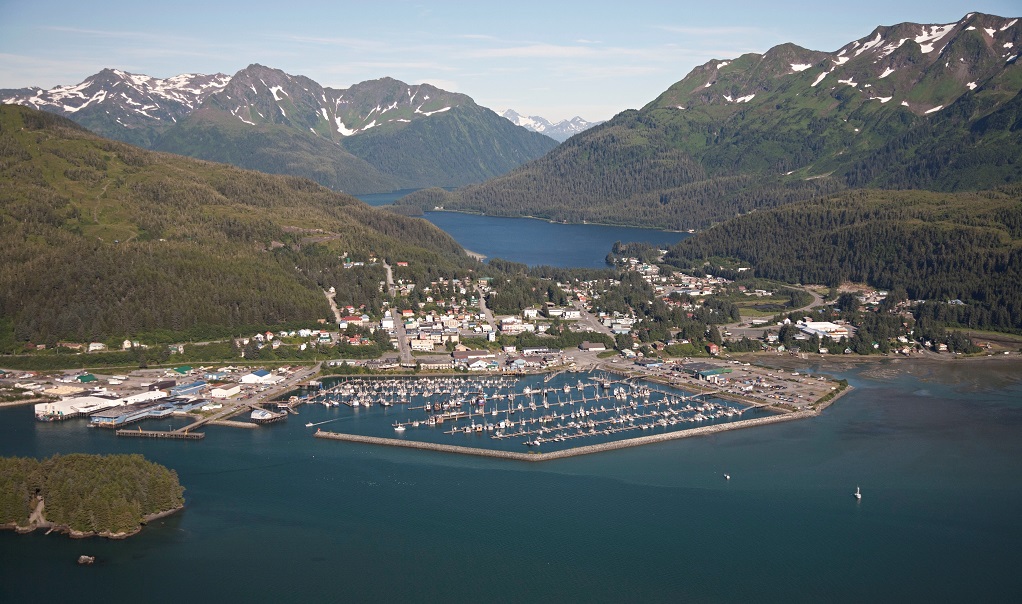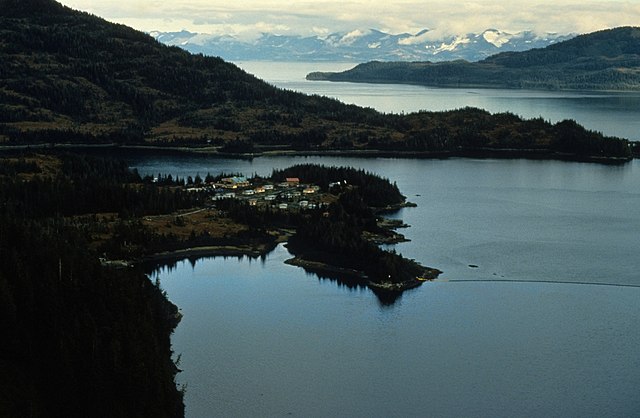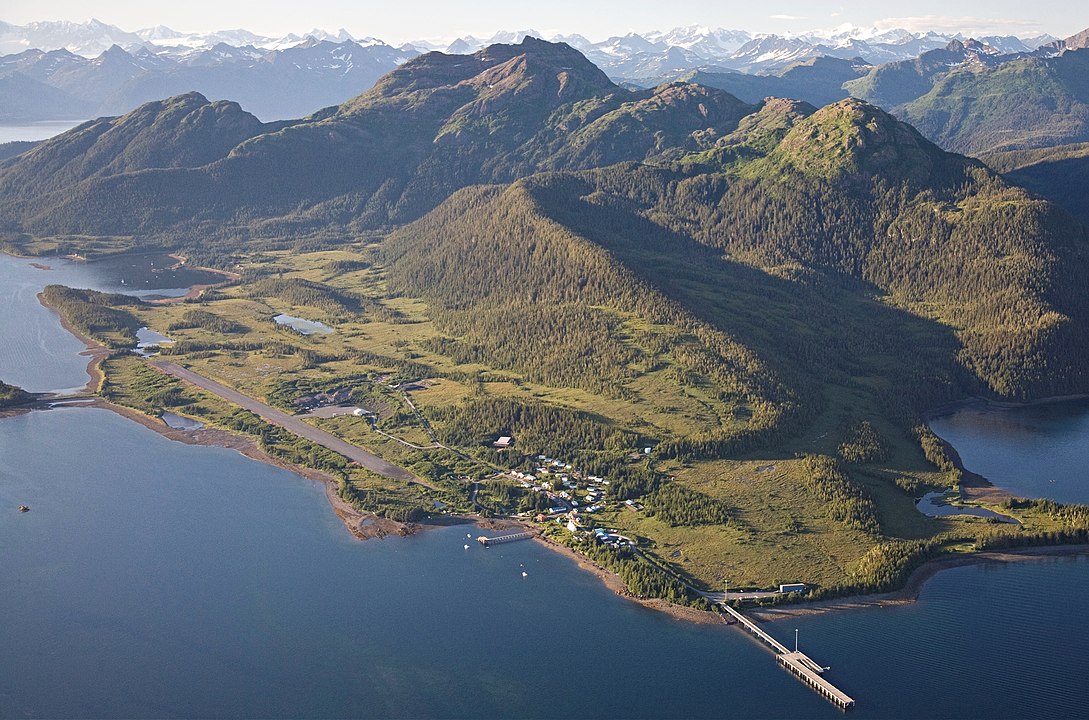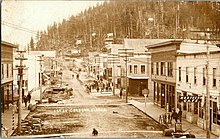Cordova Alaska lies near the mouth of the Copper River, at the head of Orca Inlet on the east side of Prince William Sound. The population was 2,609 at the 2020 census, up from 2,239 in 2010.[5]
Cordova was named Puerto Córdoba (after Córdoba, Spain) by Spanish explorer Salvador Fidalgo in 1790. Cordova is the home of the fishing fleet that supplies the famed Copper River salmon. The highly prized chinook and sockeye salmon are known for their high fat content. The fleet also fishes throughout Prince William Sound for pink and chum salmon. Halibut, Pacific cod, and coho salmon are other important fisheries to the area.

In 1790, the inlet in front of the current Cordova townsite was named Puerto Cordova by Spanish explorer Salvador Fidalgo, after Spanish admiral Luis de Córdova y Córdova. The city of Cordova was named after it, although the inlet itself was later renamed the Orca Inlet.[6] Cordova proper was founded as a result of the discovery of high-grade copper ore at Kennecott, north of Cordova. A group of surveyors from Valdez laid out a town site and Michael James Heney purchased half the land for the terminus of the Copper River and Northwestern Railway after determining that the neighboring town of Katalla was a poor harbor.[7] Heney and his crew held a brief ceremony to organize the town on March 26, 1906. A week later, crews arrived to begin work on the railroad. The first lots in the new town site, making up the heart of present-day Cordova, were sold at auction in May 1908. As the railroad grew, so did the town. Eventually schools, businesses, a hospital, and utilities were established. After the railroad was completed, Cordova became the transportation hub for the ore coming out of Kennecott. From 1911 to 1938, more than 200 million tons of copper ore were transported through Cordova.[7]
The area around Cordova was historically home to the Eyak, with a population of Chugach to the west, and occasional visits from Ahtna and Tlingit people for trade or battle.[8] The last full-blooded Eyak Marie Smith Jones died in 2008, but the native traditions and lifestyle still have an influence on the local culture. Cordova was also once the home of a booming razor clam industry. Between 1916 and the late 1950s, it was known as the “Razor Clam Capital of the World”.[9] Commercial harvest in the area reached as high as 3.5 million pounds. Returns began declining in the late 1950s, presumably due to overharvesting and a large die-off in 1958. The 1964 Good Friday earthquake effectively obliterated the industry; in some areas, the ground was thrust up by as much as six feet, exposing the already depleted clam beds. There has been no commercial harvest in the area since 1988 with the exception of a brief harvest in 1993.[10]
In March 1989 the Exxon Valdez oil tanker ran aground on Bligh Reef north of Cordova causing one of the most devastating environmental disasters in North America. The Exxon Valdez oil spill severely affected the area’s salmon and herring populations leading to a recession of the local fishing-reliant economy as well as a disruption to the area’s ecology.[11] After many years of litigation, 450 million dollars were awarded for compensatory and punitive damages.
Commercial fishing is the main industry in Cordova. Half of all households in Cordova have at least one person involved in commercial fishing or processing. The fishing fleet mainly fishes the Prince William Sound and Copper River Delta area. There are various fisheries in the area, the most economically important of which is the salmon fishery.
All Pacific salmon species except for the cherry salmon are caught. Fishermen use either a purse seine, drift gillnet, or set gillnet to catch the fish. All fisheries are regulated by the Alaska Department of Fish and Game. The fisheries in Alaska have a limited entry permit system. The first fish processing plant near Cordova opened in 1887.[20] In 2009 there were 159 purse seine, 511 drift gilnet, and 27 set gillnet permits fished in the Prince William Sound and Copper River Delta area
Various festivals and celebrations take place throughout the year. The Copper River Delta Shorebird Festival, hosted by the Cordova Chamber of Commerce, takes place each year in early May. Millions of migrating shorebirds stop in the area to rest and feed before finishing their journey north. The most numerous species are the western sandpiper, least sandpiper, and dunlin. This is a popular time for avid and casual bird watchers to visit. Activities, workshops, and bird watching tours are held throughout the week.[22]
The Cordova Iceworm Festival takes place each February. Activities include a parade, talent show, royal crowning ceremony, and various competitions such as an oyster shucking contest, ping pong tournament, and a survival suit race.[23]
Copper River Wild Salmon Festival takes place in July at the Mt. Eyak ski area and includes various events.[24] Salmon Jam Music Festival serves as one of the main events and a fund raiser for Cordova Arts, where local musicians perform followed by professional acts and takes place over the course of Friday and Saturday nights. Taste of Cordova, a wild food and Copper River salmon cook off, usually starts the events. Entries are made with a variety of wild, locally harvested foods and are judged by a panel of guest chefs and food writers. The Alaska Salmon Runs start Saturday morning and include a marathon, half marathon, 10k, 5k, and a 1-mile race on the Copper River Highway.[25] Small Fry activities are educational events for children and families that take place during the races.
The Cordova Historical Museum has exhibits on the Copper River and Northwestern Railway, the local fishing industry, and Alaska Natives. They also host a juried art show called “Fish Follies”.[26]
The Ilanka Cultural Center museum features exhibits on Eyak, Alutiiq, Ahtna and Tlingit history and contemporary life – including artifacts, photographs, and oral histories. The 24-1/2-foot orca whale, Eyak, is one of only five fully rearticulated orca whale skeletons in the world.
The Cordova Ikumat Alutiiq group was formed in 1995, composed of youth and adults, and is open to anyone who wants to join; the group performs songs from the past as well as original pieces. The Ilanka Cultural Center offers traditional arts and skills still practiced including skin sewing, beadwork; mask, totem, and ivory carving; “putting up” fish and deer; berry-picking and jam-making; and subsistence and commercial fishing.
Chenega

Aerial of Chenega Bay Village and boat harbor – Chenega Bay, Evans lsland (Prince William Sound). Close-up aerial view of Chenega, Alaska as it appeared in 1989.
Chenega (/tʃɪˈniːɡə/; Alutiiq: Caniqaq) is a census-designated place (CDP) on Evans Island in the Chugach Census Area in the U.S. state of Alaska. Located in Prince William Sound, the CDP consists of the Chugach Alutiiq village of Chenega Bay, which was established only after the Good Friday earthquake destroyed the original community on Chenega Island to the north. As of the 2020 census, the population of the CDP was 59, largely Alaska Natives; as of 2021, the population of Chenega is estimated at 49. Chenega Bay is in the Chugach School District and has one school, Chenega Bay Community School, serving approximately 16 students from preschool through high school.
The original village of Chenega, located on Chenega Island, was destroyed in 1964 by a tsunami from the Good Friday earthquake, which killed a third of the 68 people who then lived there. A post office operated here from 1946-1964.[2] Some residents moved into a refugee camp; others moved to other towns. In 1982, one family moved to Evans Island and between 1984-1991 about 26 other families migrated to the new location, now called Chenega Bay.
Former and current Chenega residents gathered each Good Friday to remember the dead of Chenega. On the 25th Good Friday after the earthquake, in 1989, the oil tanker Exxon Valdez ran aground in Prince William Sound, causing an oil spill that again devastated Chenega and other places around the area economically.

Tatitlek
Tatitlek /təˈtɪtlɪk/ (Alutiiq: Taatiilaaq; Russian: Татитлек) is a census-designated place (CDP) in Chugach Census Area, United States. The population was 88 at the 2010 census, down from 107 in 2000. Tatitlek is in the Chugach School District and has one school, Tatitlek Community School, serving about 15 students from preschool through high school.

Tatitlek first appeared on the 1880 U.S. Census as the unincorporated village of “Tatikhlek.”[4] All 73 of its residents were listed as Inuit, despite being Chugach Alutiiq.[5] In 1890, it returned as “Tatitlak.” This also included an unnamed Creole (mixed Russian and Native) village on Cordova (now Orca) Bay. Of the 90 residents, 53 were Native, 36 were Creole and 1 White.[6] In 1900, it returned as “Tatiklek.” In 1910 and in every successive census, it has returned as its present spelling of Tatitlek. It was made a census-designated place (CDP) in 1980. Within its boundaries is the former mining village of Ellamar (which reported on the 1910-20 & 1940-50 censuses. 1910: 98; 1920: 106; 1940: 23; 1950: 46).
As of the census[7] of 2000, there were 107 people, 38 households, and 28 families residing in the CDP. The population density was 14.7 people per square mile (5.7/km2). There were 57 housing units at an average density of 7.8/sq mi (3.0/km2). The racial makeup of the CDP was 14.02% White, 84.11% Native American, 0.93% Asian, and 0.93% from two or more races.
 The source for information on this page
The source for information on this page 
